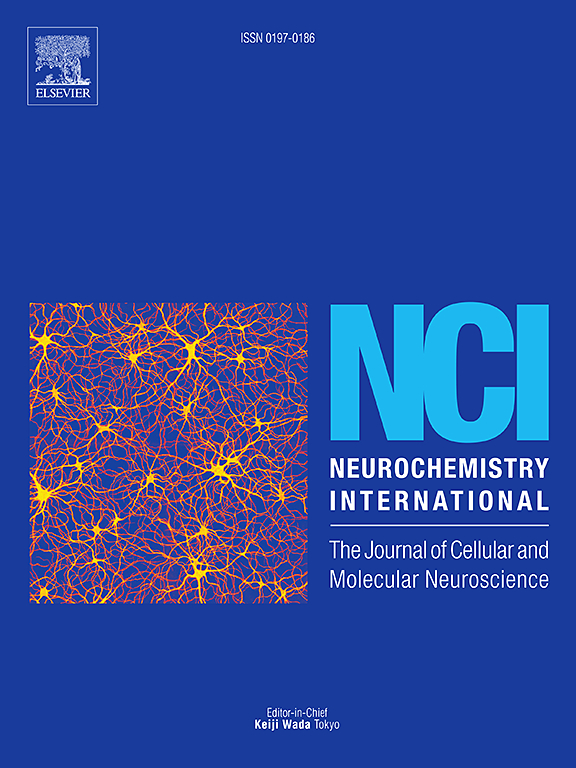Neurochemical in vivo microdialysis and postmortem tissue analysis of amygdala endocannabinoid levels after MAGL- and FAAH-inhibition in rodents
IF 4
3区 医学
Q2 BIOCHEMISTRY & MOLECULAR BIOLOGY
引用次数: 0
Abstract
This study is the first to investigate the target modulation of the MAGL inhibitor elcubragistat (ABX-1431; Lu-AG06466) and the FAAH inhibitor JNJ-42165279 in the amygdala, a brain region involved in stress-induced psychiatric disorders.
We aimed to assess dynamic changes in the endocannabinoid ligands 2-arachidonoylglycerol (2-AG) and anandamide (AEA) following pharmacological inhibition of MAGL and FAAH, enzymes regulating their metabolism.
Freely moving rats received oral doses of elcubragistat or JNJ-42165279. Microdialysis probes in the basolateral amygdala and nucleus accumbens measured extracellular 2-AG and AEA levels over 240 min using LC-MS/MS. A supplementary mouse study analyzed postmortem endocannabinoid levels in the basolateral amygdala.
MAGL inhibition by elcubragistat selectively increased extracellular and tissue 2-AG levels in the basolateral amygdala in a dose-related manner without affecting AEA. Conversely, FAAH inhibition by JNJ-42165279 selectively elevated AEA levels without altering 2-AG. Highest endocannabinoid concentration in basolateral amygdala tissue was between 2 and 4 h after MAGL or FAAH inhibition.
In vivo microdialysis is a sensitive method to study target modulation of both MAGL and FAAH inhibitors in the amygdala of freely moving rats. The results of the microdialysis study are in general agreement with postmortem tissue analysis of both 2-AG and AEA and suitable to support the preclinical drug discovery process in concert with disease related animal models.
MAGL-和faah抑制后啮齿动物杏仁核内源性大麻素水平的神经化学体内微透析和死后组织分析。
这项研究首次研究了MAGL抑制剂elcubragistat (ABX-1431;lug - ag06466)和FAAH抑制剂JNJ-42165279在杏仁核中的作用,杏仁核是一个涉及应激性精神疾病的大脑区域。我们旨在评估内源性大麻素配体2-花生四烯醇甘油(2-AG)和anandamide (AEA)在药物抑制MAGL和FAAH(调节其代谢的酶)后的动态变化。自由活动的大鼠口服elcubragistat或JNJ-42165279。基底外侧杏仁核和伏隔核的微透析探针在240分钟内使用LC-MS/MS测量细胞外2-AG和AEA水平。一项补充小鼠研究分析了死后杏仁核基底外侧的内源性大麻素水平。elcubragistat对MAGL的抑制作用以剂量相关的方式选择性地增加了杏仁核基底外侧细胞外和组织2-AG水平,而不影响AEA。相反,JNJ-42165279抑制FAAH选择性地提高了AEA水平,而不改变2-AG。在MAGL或FAAH抑制后2 - 4小时内,杏仁核基底外侧组织内源性大麻素浓度最高。体内微透析是一种灵敏的方法来研究MAGL和FAAH抑制剂在自由运动大鼠杏仁核中的靶调节。微透析研究的结果与2-AG和AEA的死后组织分析基本一致,适合支持与疾病相关动物模型一致的临床前药物发现过程。
本文章由计算机程序翻译,如有差异,请以英文原文为准。
求助全文
约1分钟内获得全文
求助全文
来源期刊

Neurochemistry international
医学-神经科学
CiteScore
8.40
自引率
2.40%
发文量
128
审稿时长
37 days
期刊介绍:
Neurochemistry International is devoted to the rapid publication of outstanding original articles and timely reviews in neurochemistry. Manuscripts on a broad range of topics will be considered, including molecular and cellular neurochemistry, neuropharmacology and genetic aspects of CNS function, neuroimmunology, metabolism as well as the neurochemistry of neurological and psychiatric disorders of the CNS.
 求助内容:
求助内容: 应助结果提醒方式:
应助结果提醒方式:


